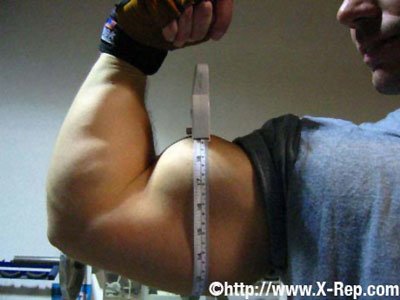| Article Summary: |
Looking to put on some serious size? It's not all that hard, you just need to come up with a game plan that is solid and sound. By following the steps found in this article, you will find yourself putting on size in no time.

Step 1:
Getting Your Diet In Check
Diet is the key element when bulking or cutting. No matter your goal, without having your diet in check you will only be cutting yourself short. You still want to be taking in your 5-7 meals throughout the day, however make sure you are adding some extra calories to each of these meals.
When looking to add some serious mass, make sure you are taking in at least 1g of protein per pound of bodyweight. Your carbohydrates should be anywhere from 2-4g per pound of bodyweight.
You can always adjust your calorie intake and carbs throughout the weeks by checking your body fat. If you find your body fat increasing (remember, when adding mass you will add a little body fat) quickly, take a look at your diet and adjust your calories and carbs accordingly.
Here you will find some good food sources to utilize during your mass-gaining program:

Proteins
- Boneless, Skinless Chicken Breast
- Tuna (Water Packed)
- Fish (Salmon, Sea Bass, Halibut)
- Shrimp
- Extra Lean Ground Beef
- Protein Powder
- Egg Whites or Eggs
- Rib-Eye Steaks Or Roast
- Top Round Steaks Or Roast
- Top Sirloin
- Beef Tenderloin
- Top Loin
- Flank Steak
- Eye of Round
- Ground Turkey, Turkey Breast Slices Or Cutlets (Fresh Meat, Not Deli Cuts)
| RELATED ARTICLE | |||
|
Author: Sergio Merino |

Complex Carbs
- Oatmeal
- Sweet Potatoes Or Yams
- Beans (Pinto, Black, Kidney)
- Oat Bran Cereal
- Brown Rice
- Farina (Cream of Wheat)
- Multigrain Hot Cereal
- Pasta
- Rice (White, Jasmine, Basmati, Arborio, Wild)
- Potatoes (Red, Baking, New)

Fibrous Carbs
- Green Leafy Lettuce (Green Leaf, Red, Leaf, Romaine)
- Broccoli
- Asparagus
- String Beans
- Spinach
- Bell Peppers
- Brussels Sprouts
- Cauliflower
- Celery
|
|||
|
|||
|

Other Produce & Fruits
- Cucumber
- Green Or Red Pepper
- Onions
- Garlic
- Tomatoes
- Zucchini
- Fruit (If acceptable on diet: Bananas, Apples, Grapefruit, Peaches, Strawberries, Blueberries, Raspberries)
- Lemons or Limes

Healthy Fats
- Natural Style Peanut Butter Or Almond Butter
- Olive Oil, Safflower Oil, Almond Oil, Flaxseed Oil
- Nuts (Peanuts, Almonds, Walnut)
- Canola, and Peanut - Monounsaturated Oils
- Sunflower, Corn, Soybean, and Cottonseed - Polyunsaturated Oils
- Omega-6
- Omega-3
- Fatty Coldwater Fish (Mackerel, Salmon, Bluefish, Mullet, Sablefish) - EPA and DHA
- More fish (Menhaden, Anchovy, Herring, Lake Trout, Sardines, Tuna) - EPA and DHA
 |
How Important Is Dietary Fat To A Bodybuilder? It's so obvious how important proteins and carbohydrates are to a bodybuilder... However, fats seem to be often overlooked in a bodybuilder's nutrition plan. Learn more. [ Check Out The Topic Of The Week Here ] |

Dairy & Eggs

Water
-
Make sure you stay hydrated throughout the day. It is important to be
drinking water not only during training, but before and after. Water helps flush out toxins in the body and will keep your body and organs functioning properly. I recommend taking in at least 1 gallon of water a day.
|
|||
|
|||
|

Step 2:
Putting Together A Workout Program
The key here is to hit the weights hard and heavy. If you want to add some serious size you will need to be pushing some serious weight. Continue to keep your reps around the 8-12 range and maintain 3-4 sets per exercise. When trying to put on size people tend to overtrain by thinking more is better - not the case.
Be smart and keep your larger muscle groups around 10-12 total working sets and the smaller muscle groups around 8-10 total working sets. Keep your workouts intense and no more than 45-60 minutes.
There are many different types of workout splits you can use when trying to gain size. The best option is to hit the muscle group hard and allow it to recover a full week before hitting it again. I would recommend one of the routines below.
| RELATED ARTICLE | |||
|
Author: X-Rep.com |

Routine 1:
- Day 1- Chest/Triceps
- Day 2- Back/Biceps
- Day 3- Rest
- Day 4- Quads/Hamstrings
- Day 5- Rest
- Day 6- Shoulders/Calves
- Day 7- Rest

Routine 2:
- Day 1- Chest
- Day 2- Back
- Day 3- Rest
- Day 4- Quads/Calves
- Day 5- Hamstrings/Shoulders
- Day 6- Arms
- Day 7- Rest

Routine 3:
- Day 1- Chest
- Day 2- Back
- Day 3- Quads
- Day 4- Rest
- Day 5- Hamstrings
- Day 6- Arms
- Day 7- Shoulders/Calves

Step 3:
Cardio
I am a strong believer in doing cardio year round. Not only does this keep the heart healthy but it cuts down on putting on excess body fat throughout the year. I will say this though - when trying to put on mass it is wise to only do a few days of cardio and keep it to a low-intensity. This could be something like a walk or a non-intense bike ride.
Keep the cardio session around 30 minutes. This can be done on your rest days or after training. When trying to add mass don't freak out if you put on a little body fat, it is bound to happen because you are increasing your calories. But by keeping some cardio in your routine, adding excessive amount of body fat can be kept to a minimum.

Step 4:
Rest
With everyone busy with jobs and life in general, some people put sleep on the back burner and only get in a few hours each night. Not getting enough rest when trying to put on some quality mass is like trying to have a plant grow without water or the sun. It just won't happen.
You need proper rest to allow your muscles time to recover and grow. 8 hours of sleep is the minimum you should be getting every night. If your day permits it, try and fit in a nap during the day as well. Not only will you feel refreshed for the rest of the day, but it also gave your body some extra time to rest and grow.
| RELATED ARTICLE | |||
|
Author: Marie Spano |
Remember, muscles don't grow inside the gym... they grow outside of the gym. Hit it hard in the gym, feed the muscles, and then allow them rest and recover.

Step 5:
Supplementation
When trying to add mass there are definitely some supplements that you should consider buying. Below you will find a couple that I feel are very crucial and beneficial for adding size (not counting multivitamins and EFA's which should be taken every day no matter if you workout or not) and that won't break the bank.

Protein Powder:
-
This is a no-brainer and a must have. When trying to add size you need to take in at least 1g of protein per pound of bodyweight. Some people can't eat enough
protein throughout the day to reach that number. Protein powders allow you to drink a meal and add a good amount of protein at one sitting.
Protein powders are reasonably priced and are very convenient.
Top Selling Protein Powders:
- 100% Whey Protein - By Optimum
- Syntha-6 - By BSN
- Muscle Milk - By CytoSport
- Other Protein Powders...

Creatine:
-
Creatine has been studied for years and the research keeps getting better. This is a sure and safe way to put on some size and
strength. Creatine will give you more energy during your workouts and will allow you to recover quicker between sets. It will flood your muscles with water and help keep your muscles full and saturated.
| RELATED ARTICLE | |||
|
Author: Mark Faulkner |
-
Creatine can be purchased in pill form, capsules, liquid, and powder. There are many different types of creatine out on the market these days, I recommend starting with creatine monohydrate and see how that works for you. Monohydrate is the simplest form of creatine and is also the least expensive.
| Check Out Matt Weik's BodySpace | ||
|












